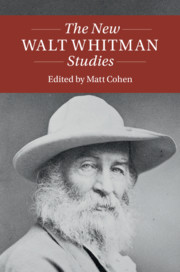Book contents
- The New Walt Whitman Studies
- Twenty-First-Century Critical Revisions
- The New Walt Whitman Studies
- Copyright page
- Contents
- Figures
- Contributors
- Acknowledgments
- Introduction
- Part I The New Life of the New Forms: Aesthetics, Disciplines, Politics
- Chapter 1 Whitman’s “Deathbed” Radicalism and Its Modernist Effects
- Chapter 2 Whitman, Women, and Privacy
- Chapter 3 The Poetics of a New Science: “Song of Myself” as Sociology
- Chapter 4 World Wide Walt: Making and Marketing Whitman’s Global Persona
- Chapter 5 Intimacies of Place: Walt Whitman and the Politics of Settler Sensation
- Part II Wet Paper Between Us: New Reading Methods
- Part III A Kosmos: The Critical Imagination
- Index
Chapter 5 - Intimacies of Place: Walt Whitman and the Politics of Settler Sensation
from Part I - The New Life of the New Forms: Aesthetics, Disciplines, Politics
Published online by Cambridge University Press: 03 November 2019
- The New Walt Whitman Studies
- Twenty-First-Century Critical Revisions
- The New Walt Whitman Studies
- Copyright page
- Contents
- Figures
- Contributors
- Acknowledgments
- Introduction
- Part I The New Life of the New Forms: Aesthetics, Disciplines, Politics
- Chapter 1 Whitman’s “Deathbed” Radicalism and Its Modernist Effects
- Chapter 2 Whitman, Women, and Privacy
- Chapter 3 The Poetics of a New Science: “Song of Myself” as Sociology
- Chapter 4 World Wide Walt: Making and Marketing Whitman’s Global Persona
- Chapter 5 Intimacies of Place: Walt Whitman and the Politics of Settler Sensation
- Part II Wet Paper Between Us: New Reading Methods
- Part III A Kosmos: The Critical Imagination
- Index
Summary
This chapter is about the fitful fantasy of sexually and socially horizontal relations. With attention to Whitman’s style and compositional methods, it tracks the intimate gestures or “haptic feelings” that move between the mimetic and the ontic: the hold, the fold, and the press. Doing so illuminates Whitman’s view of the sensorium as the switch-point where representation runs off the printed page to become a thing in the world. In tipping over from the mimetic to the ontic, the haptic discloses the political asymmetries that crosscut the poet’s “object-oriented” fantasies: The hold attaches the catalog to the slave ship; the fold attaches the page to the “adhesive” brain; the press attaches print type to bodily thrusts. This chapter argues that the haptic organizes the turbulent interdependencies of race, sex, and gender that underwrote a poetic project aiming to reconcile sociality’s immediate yet ephemeral intimacy with print’s mediated yet durable intimacy.
- Type
- Chapter
- Information
- The New Walt Whitman Studies , pp. 83 - 98Publisher: Cambridge University PressPrint publication year: 2019

